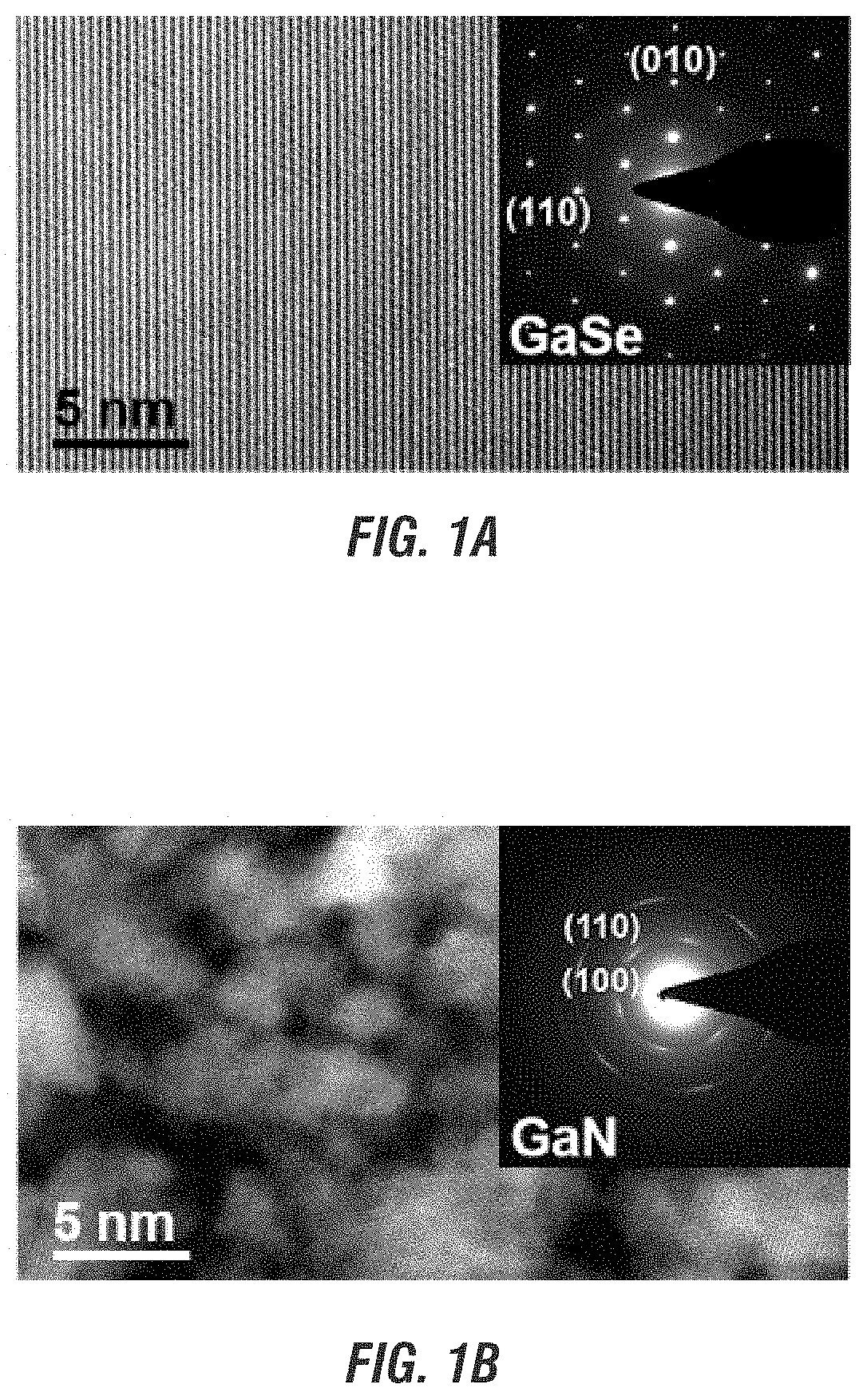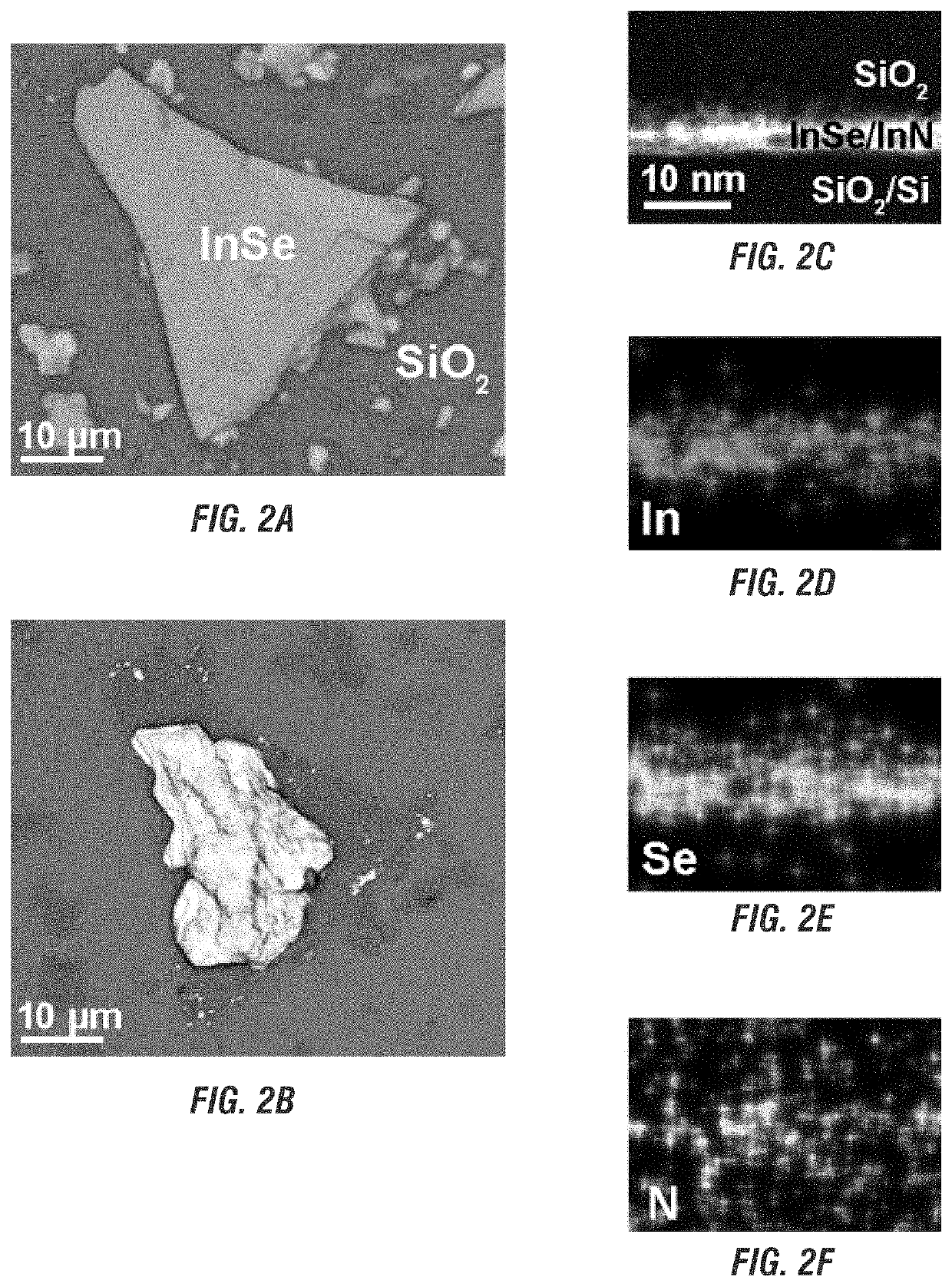Method of growing crystalline layers on amorphous substrates using two-dimensional and atomic layer seeds
a technology of amorphous substrates and crystalline layers, applied in the direction of crystal growth process, polycrystalline material growth, chemically reactive gases, etc., can solve the problems of significant limitations in the synthesis of high-quality single-crystalline group iii-v films, lack of native substrates, and significant limitations in the synthesis of nitride materials. achieve the effect of enhancing chemical vapor deposition
- Summary
- Abstract
- Description
- Claims
- Application Information
AI Technical Summary
Benefits of technology
Problems solved by technology
Method used
Image
Examples
example 1
[0127]Single-crystal, mono- to few-layer GaSe layers were synthesized via powder vaporization of 7-12 mg bulk GaSe crystals placed beneath face-down 1×1 cm substrates of 300 nm SiO2 / Si or epitaxial graphene on SiC. GaSe crystal powders were vaporized beneath the substrates at temperatures from 700-850° C. for 30 minutes, under a constant flow of 200 sccm Ar and a pressure of 300 Torr. A ramp rate of 20° C. per minute was used to bring the furnace to growth temperature and the rate of rise of pressure in the tube furnace was ensured to be less than or equal to 5 mTorr per minute before each growth process. The furnace was cooled naturally to room temperature prior to sample removal.
[0128]The GaSe layers were then placed in a tube furnace and heated to 600° C. at 600 Torr, under constant flow of Ar at 100 sccm. A furnace ramp rate of 200° C. per minute was maintained and 100 sccm of NH3 was introduced once the furnace reached nitridation temperature. The furnace was cooled naturally t...
example 2
[0129]Exfoliated InSe layers were subjected to ammonolysis at temperatures above 500° C., leading to an etching effect of InSe layers rather than the transformation to InN, even at process times longer than 90 minutes, as shown in FIG. 2, indicating differences in atomic-level interactions between NH3 and different Group-III chalcogenides.
example 3
[0130]Multilayer GaSe exposed to NH3 for 30 minutes, not long enough for complete nitridation, exhibits a bilayer-type structure where the top layers are GaxSeyNz and the bottom layers remain single-crystal GaSe, as indicated in FIG. 3. Images (g) and (h) in FIG. 3 show Se deficiency in the outer, amorphous region along with a small nitrogen signal. This indicates the transformation involves the structural decomposition of GaSe followed by reaction with nitrogen. The presence of this amorphous, ternary outer layer in partially transformed bulk GaSe suggests that rather than the occurrence of a simple Se and N exchange, transformation to GaN requires significant structural changes.
[0131]Moreover, GaSe layers fabricated by exfoliation show nanocrystalline material following ammonolysis, as shown in FIG. 4, further indicating a chemical reaction and structural modification has taken place.
PUM
| Property | Measurement | Unit |
|---|---|---|
| thickness | aaaaa | aaaaa |
| thickness | aaaaa | aaaaa |
| thick | aaaaa | aaaaa |
Abstract
Description
Claims
Application Information
 Login to View More
Login to View More - R&D
- Intellectual Property
- Life Sciences
- Materials
- Tech Scout
- Unparalleled Data Quality
- Higher Quality Content
- 60% Fewer Hallucinations
Browse by: Latest US Patents, China's latest patents, Technical Efficacy Thesaurus, Application Domain, Technology Topic, Popular Technical Reports.
© 2025 PatSnap. All rights reserved.Legal|Privacy policy|Modern Slavery Act Transparency Statement|Sitemap|About US| Contact US: help@patsnap.com



